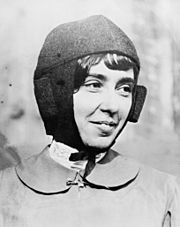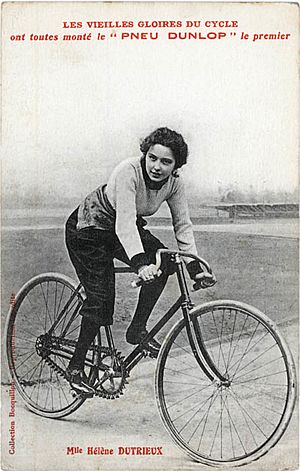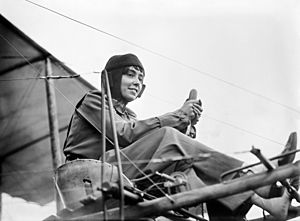Hélène Dutrieu facts for kids
Quick facts for kids
Hélène Dutrieu
|
|
|---|---|

Hélène Dutrieu dressed for flying
|
|
| Born | 10 July 1877 |
| Died | 26 June 1961 (aged 83) Paris, France
|
| Occupation | Cycle racer, stunt driver and pilot |
| Spouse(s) | Pierre Mortier |
Hélène Dutrieu (born July 10, 1877 – died June 26, 1961) was an amazing Belgian woman. She was a world champion in cycling and later became a daring stunt performer. Hélène was also a pioneer pilot, one of the first women to fly airplanes! During World War I, she drove ambulances and even managed a military hospital.
Contents
About Hélène
Hélène Marguerite Dutrieu was born in Tournai, Belgium, on July 10, 1877. Her father was an officer in the Belgian Army. Later, her family moved to Lille, a city in northern France. Hélène started working at just 14 years old to help her family.
Becoming a Cycling Champion
Hélène Dutrieu started her cycling career because her older brother, Eugène, was a professional cyclist. She became a professional track cyclist, racing for the Simpson Lever Chain team. In 1893, she set a new women's world record for the distance cycled in one hour.
Hélène won the women's speed track cycling world championship twice. She won in 1896 and 1897 in Ostend, Belgium. However, she lost her title in 1898 to Louise Roger. In November 1896, she won a long 12-day race in London, England. In August 1898, she won the "Grand Prix of Europe." Leopold II of Belgium gave Dutrieu a special award, the Cross of St André with diamonds, for her cycling success. Later, she also raced motorcycles and cars.
Daring Stunt Performer
Hélène began performing in variety shows. She had a special cycling act. In July 1903, she cycled a full loop inside a vertical track in Marseille, France. She also invented her own stunt called "La Flèche Humaine" ("The Human Arrow"). This stunt involved jumping about 15 meters with her bicycle!
In September 1903, she performed in Paris. She also showed her stunts in London, Berlin, and other big cities. Later, she moved on to motorcycle stunts. These included "La Moto Ailée" and "Saut dans la Lune." After a bad crash in Berlin in 1904, she had to rest for eight months to get well again.
Acting on Stage
In 1903, Hélène Dutrieu had a small role in a play at the Déjazet theatre. She played a character named Hélène. After she recovered from her motorcycle crash, she returned to the theatre. From 1906 to 1909, she performed in comedies. She acted on famous stages like the Théâtre des Capucines and the Théâtre Michel.
Achievements in Aviation
Hélène Dutrieu learned to fly an airplane in early 1910. She used a Santos-Dumont Demoiselle monoplane. On April 19, 1910, she became the first female pilot to fly with a passenger. On November 25, 1910, Dutrieu received her pilot's license. She was the fourth woman in the world and the first Belgian woman to get one.
Her amazing flights at air shows earned her the nickname "Girl Hawk". People were surprised when it was reported that she did not wear a corset while flying. She also cared about style. She wore the first known high-fashion pilot suit, designed by a famous Paris designer.
In September 1910, Dutrieu flew non-stop from Ostend to Bruges, Belgium. From September 26 to October 1, she flew often with passengers in England. She was the first woman pilot to stay in the air for more than an hour. On December 21, 1910, she won the Coupe Femina (Femina Cup). She flew 167 kilometers in 2 hours and 35 minutes without stopping.
In 1911, she temporarily won the Coupe Femina again. She flew 254 kilometers in 2 hours and 58 minutes. However, Marie Marvingt eventually won that year's cup. In September 1911, Dutrieu traveled to the United States with her Farman III biplane. She competed for the women's altitude record and a special trophy. In the same year, Dutrieu beat 14 male pilots to win the Coppa del Re (King's Cup) in Florence, Italy.
In 1912, she became the first woman to pilot a seaplane. Later that year, she won a prize in a competition against four other seaplane pilots in Switzerland. In 1913, Dutrieu became the first woman aviator to be given membership in the Légion d'honneur (French Legion of Honour). This is a very important award in France.
World War I and Later Life
During World War I, Hélène Dutrieu became an ambulance driver. A general put her in charge of the ambulances at Messimi Hospital. She later became the director of a military hospital. After the war, she became a journalist.
In 1922, she married Pierre Mortier and became a French citizen. She later became the vice president of the women's section of the Aéro-Club de France (Aero Club of France). In 1956, she created the Coupe Hélène Dutrieu-Mortier (Hélène Dutrieu-Mortier Cup). This award gave 200,000 francs to the French or Belgian female pilot who made the longest non-stop flight each year.
Her Final Years
Hélène Dutrieu passed away in Paris, France, on June 26, 1961. She was 83 years old.
Awards and Honors
- 1898: Awarded the Cross of St. Andre with diamonds by Leopold II of Belgium.
- 1910 December 21: Won the Aéro-Club de France's (Aero Club of France) Coupe Femina (Femina Cup).
- 1913: Named a member of the légion d'honneur (French Legion of Honour).
See also
 In Spanish: Hélène Dutrieu para niños
In Spanish: Hélène Dutrieu para niños



